|
Fieseler Fi 156 C Storch
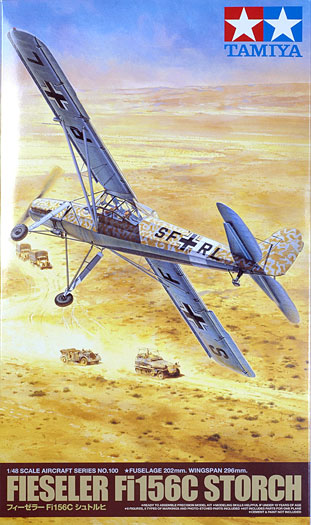
Tamiya, 1/48 scale
S
u m m a r y
|
| Catalogue Number: |
Tamiya Kit No. 61100 - Fieseler Fi
156 C Storch |
| Scale: |
1/48 |
| Contents and Media: |
152 parts in grey plastic; two parts
in grey and clear; eight clear parts; eight poly caps; steel landing
gear and spar; photo-etched fret; self-adhesive masking sheet; six
figures made up of 25 grey parts; fuel drums, jerry cans, packs and a
bucket (an additional 46 parts). |
| Price: |
¥5200 |
| Review Type: |
FirstLook |
| Advantages: |
Highly detailed; convincing surface
textures including fabric and stitching; separate flaps, ailerons,
leading edge slats and entry door; interesting options for different
versions (skis, drop tank etc) ; full Argus engine detail; clever
engineering (e.g. steel wing spar, integrated clear and grey fuselage);
appropriate use of multi-media; six figures included; self-adhesive
canopy masks supplied; excellent instructions and support material; |
| Disadvantages: |
|
| Recommendation: |
Highly Recommended. |
Reviewed
by
Brett Green

Tamiya's 1/48 scale Fieseler Fi 156 C Storch will be available
online from Squadron.com
Whether it is by accident or design, a number of Tamiya's
most significant kits have been released at the very end of the year.
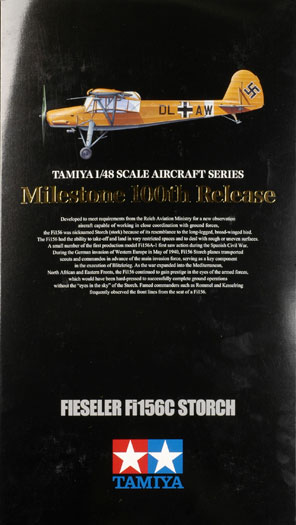 In
1998, the 1/35 scale Dragon Wagon tank transporter was unveiled. This model
changed our expectations about the size and detail of military vehicle kits.
The end of 1999 was the turn of Axis military fans with the 1/35 scale
Tamiya FAMO. In December 2000, Tamiya topped its own effort by adding the
Sd.Ah.116 tank trailer to the FAMO prime mover. In
1998, the 1/35 scale Dragon Wagon tank transporter was unveiled. This model
changed our expectations about the size and detail of military vehicle kits.
The end of 1999 was the turn of Axis military fans with the 1/35 scale
Tamiya FAMO. In December 2000, Tamiya topped its own effort by adding the
Sd.Ah.116 tank trailer to the FAMO prime mover.
Christmas 2007 saw me once again listening for the courier
van in the driveway, awaiting Tamiya's latest kit. I was not disappointed.
Tamiya's 100th kit in their 1/48 Scale Aircraft Series is a
Fieseler Fi 156 C Storch.
The Fieseler Storch may seem to be an unusual choice for
this important milestone. We already have a decent (albeit very old and
currently unavailable) 1/48 scale Storch from ESCI. Also, transport and
communication aircraft often do not have the consumer appeal of fighters.
However, any doubts about the subject choice evaporated as
soon as I opened the box.
Tamiya has packed their milestone 100th release inside a
glossy black cardboard sleeve embossed with gold lettering. A conventional
top-opening box slides out, exposing attractive cover art of a desert Storch
circling a German column of vehicles. The artwork is presented in portrait
format . Perhaps this unusual orientation is a hint that this kit is just a
bit different to those that have gone before it. The box is surprisingly
heavy considering the size of the aircraft.
Opening the box reveals the first surprise. The fuselage
halves are moulded in both clear and grey plastic. The clear plastic
has been bonded to the grey styrene as part of the manufacturing process.
This will eliminate the risk of smearing glue over the edges of the
prominent canopy, and will guarantee perfect alignment in this vital area.
Multi-media parts are packed separate from the general
contents. A small photo-etched fret supplies armour plate, the pilot's seat
mount and a side panel mounted on the cockpit frame. A steel wing spar plus
a wire landing gear strut are also included.
In total, the kit itself comprises 152 parts in grey
plastic; two parts in grey and clear; eight clear parts; eight tiny poly
caps; the steel landing gear and spar plus the photo-etched fret. A
self-adhesive masking sheet is supplied for the large glasshouse canopy. In
addition, there are six figures made up from 25 grey parts; and some diorama
accessories in the form of fuel drums, jerry cans, packs and a bucket. This
accessory sprue contains an extra 46 parts.
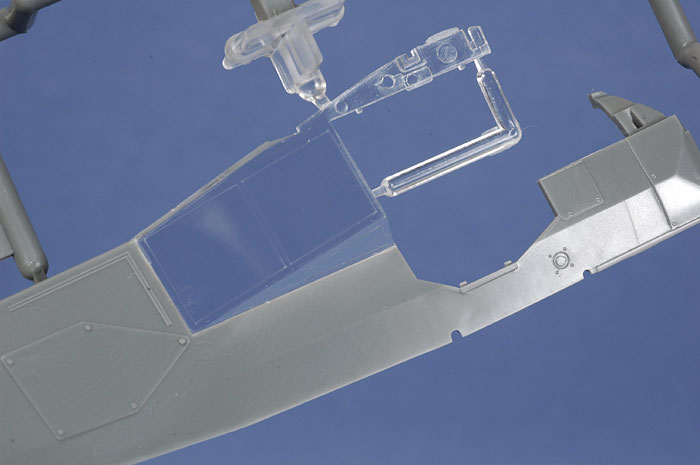
Click the thumbnails below to view
larger images:
Surface texturing is superb. Fabric rendition is subtle and
very convincing, and the metal reinforcing plates at the wing roots are an
appropriate contrast. The bottom of the fuselage is finished with
exquisitely moulded stitching.
The level of detail is equally good. A full Argus engine is
supplied in 19 pieces. All four engine cowls are separate, so the modeller
may choose to display part or all of this engine.
The cockpit of the real aircraft was quite basic, but all
the features are present here including the internal framing, oil tank,
bulkheads and other structural components. A lovely MG 15 machine gun and
spare ammunition containers are also present.
The wings feature separate flaps, ailerons and leading edge
slats. The ailerons and flaps may be posed up or down according to the
modeller's choice with the aid of different mounts for the dropped or
neutral positions.
The main entry door is separate, and may be glued open or
closed.
Other options include a fuselage mounted fuel tank and skis.
The model may be built as an Fi 156 C-3, C-3/trop, C-5 or
C-7 variant. All the parts are supplied to model any of these variations,
including top canopy with or without armament.
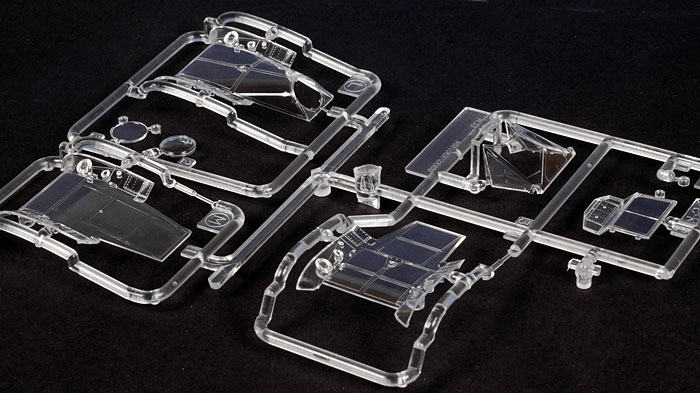
The kit engineering is noteworthy. Any model with a
glasshouse canopy and high mounted wings presents a challenge in
establishing a robust join between the clear parts and the wings. Tamiya has
risen to this challenge by providing a wide steel spar that will mount the
wings securely to the clear canopy without obscuring the prominent cockpit
interior.
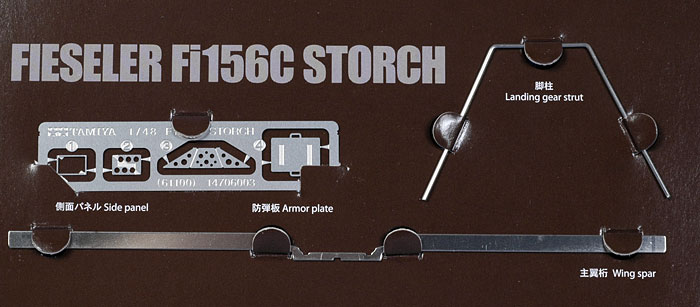
Another innovation is the stout steel wire main landing gear
part. In fact, this part acts as both landing gear legs and a brace for the
top of the cockpit. The undercarriage fairings simply slide over the wire
legs, and the remaining landing gear parts are glued to the plastic fairing.
Very clever stuff.
The inclusion of masks is very welcome, especially
considering the prominence of the big glasshouse canopy. Similar to masks
provided Tamiya's 1/48 scale Fw 190 A-8/R2, the self-adhesive sheet is
printed with labelled masking shapes, which the modeller cuts out and
applies to the model.
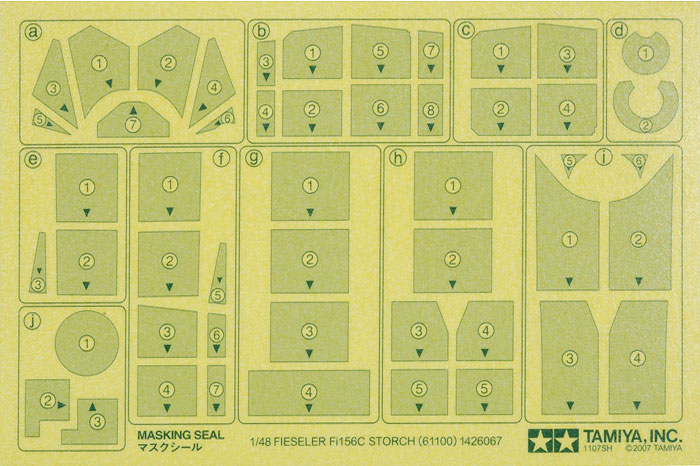
Markings are supplied for five varied aircraft:
-
Fi 156 C-3/trop used by
Field Marshall Erwin Rommel during 1942. This is finished in RLM 79
Sandy Yellow with a Light Blue squiggle.
-
another Fi 156 C-3/trop used
by Field Marshall Erwin Rommel during 1942. This is finished in RLM 79
Yellow with RLM 78 Light Blue lower surfaces.
-
Fi 156 C-3 used in the Gran
Sasso raid on 12 September 1943 to free Mussolini.
-
Fi 156 C-7, unit unknown.
Both these aircraft are finished in standard RLM 70, 71, 65.
-
Fi 156 C-5 fitted with skis
and an auxiliary tank, Eastern Front 1942, with a brushed coat of winter
whitewash over its standard finish.
Decals are printed in perfect register.
Click the thumbnails below to view
larger images:
The six figures comprise one seated pilot and passenger, two
standing figures of Rommel (one in greatcoat, one in Afrika Corps uniform),
and two additional standing figures. One appears to be a Luftwaffe officer,
and the second is an NCO in Afrika Corps uniform.
Tamiya's 1/48 scale Fi 156 Storch is beautifully detailed,
convincingly textured, makes excellent use of multi-media parts and features
innovative kit engineering. The inclusion of six figures plus the diorama
accessories is a nice bonus.
This is a worthy celebration of Tamiya's 100th kit in their
1/48 Scale Aircraft Series, and a potent reminder that Tamiya is still very
much at the forefront of the plastic model aeroplane market.
Highly Recommended.
Sample purchased by HyperScale
Text and Images Copyright © 2007 by Brett Green
Page Created 28 December, 2007
Last updated 31 December, 2007
Back to HyperScale Main Page
Back to Reviews Page
|
Home
| What's New |
Features |
Gallery |
Reviews |
Reference |
Forum |